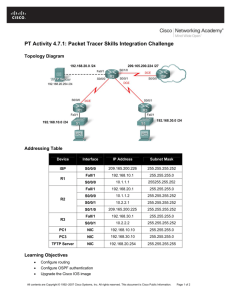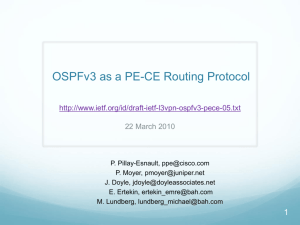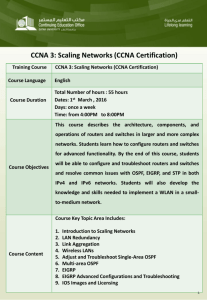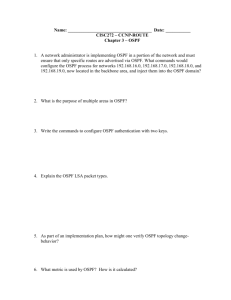Lab 3-5 Debrief Implementing a Scalable Multiarea Network OSPF- Based Solution —3-1
advertisement
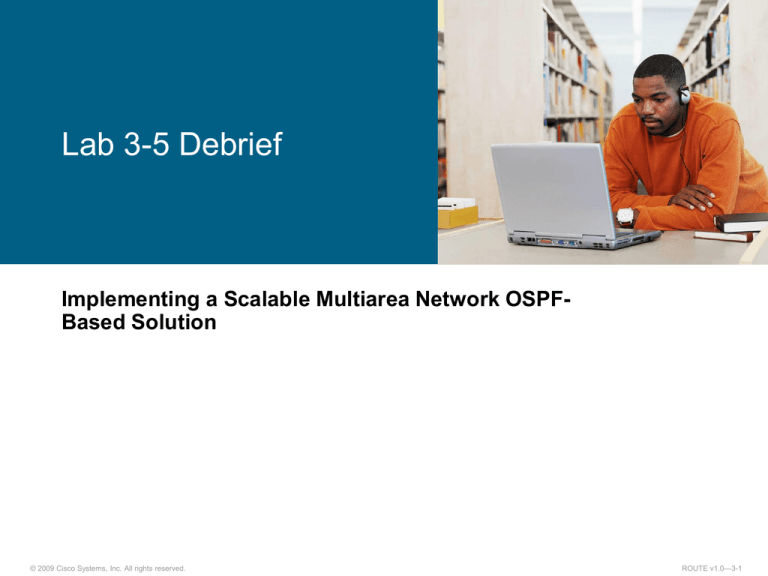
Lab 3-5 Debrief Implementing a Scalable Multiarea Network OSPFBased Solution © 2009 Cisco Systems, Inc. All rights reserved. ROUTE v1.0—3-1 Lab Topology © 2009 Cisco Systems, Inc. All rights reserved. ROUTE v1.0—3-2 Lab Review: What Did You Accomplish? Task 1: Examining OSPF Routing Information – How can you verify the operation of an OSPF routing protocol? – What can you see by observing the OSPF neighbors, OSPF database, OSPF interfaces, and IP routing table? Task 2: Enabling OSPF Link Authentication – How is OSPF link authentication between two routers implemented? Task 3: Enabling OSPF Area Authentication – How is OSPF area authentication implemented on a router? © 2009 Cisco Systems, Inc. All rights reserved. ROUTE v1.0—3-3 Verification Did you have enough information to create an implementation plan? Were you able to define the OSPF topology and the contents of the IP routing table? Verify that after link authentication configuration, the adjacencies, IP routing table, and OSPF database are included into OSPF. Examine the OSPF link authentication process. Verify that after link authentication configuration, the adjacencies, IP routing table, and OSPF database are included into OSPF. Examine the OSPF area authentication process. Verify that when a router with an improper or missing OSPF authentication is connected to the area, an OSPF adjacency is not set up. © 2009 Cisco Systems, Inc. All rights reserved. ROUTE v1.0—3-4 Checkpoints Examine the IP routing information exchanged by routers configured with the OSPF routing protocol. Configure OSPF link authentication on the LAN segment. Check the IP routing table and OSPF database to verify that the adjacency on that link is up and link is included in the OSPF process. Configure OSPF area authentication. Check the IP routing table and OSPF database to verify that the adjacencies in the area are up and the links are included in the OSPF process. Check for the OSPF information in the router where area authentication is not configured. © 2009 Cisco Systems, Inc. All rights reserved. ROUTE v1.0—3-5 A Sample Solution The OSPF topology and OSPF operation are verified, along with the IP routing table, which shows the OSPF routes. OSPF link authentication is configured on the LAN segment. OSPF area authentication is configured in the whole area. MD5 authentication is used as the highest security provided in the OSPF. © 2009 Cisco Systems, Inc. All rights reserved. ROUTE v1.0—3-6 Alternative Solutions Different authentication types can be used (clear text instead of MD5). Different areas and redistribution can be used to control the updates, but they do not provide authentication. © 2009 Cisco Systems, Inc. All rights reserved. ROUTE v1.0—3-7 Q and A How can you verify the OSPF routes in an IP routing table? How many authentication types are supported by OSPF? How do you configure OSPF link authentication? How do you configure OSPF area authentication? Is OSPF area authentication applied to all OSPF-enabled interfaces on the router where it is configured? © 2009 Cisco Systems, Inc. All rights reserved. ROUTE v1.0—3-8 Summary IP routing information exchanged by routers that are configured with the OSPF routing protocol is examined. Simple OSPF authentication is configured between routers on a LAN segment. You do not only deploy OSPF area authentication on each link, but also in the whole area, for which all OSPF interfaces are involved. © 2009 Cisco Systems, Inc. All rights reserved. ROUTE v1.0—3-9 © 2009 Cisco Systems, Inc. All rights reserved. ROUTE v1.0—3-10
